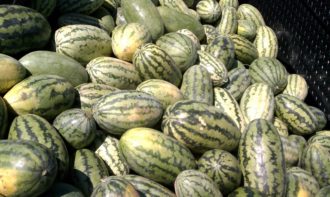FORT PIERCE, Florida – University of Florida researchers, through a Southern Sustainable Agriculture Research & Education grant, have found a natural method of reducing post-harvest citrus fruit decay.
In a SSARE Graduate Student Grant study, researchers found that essential oils, specifically carvacrol and thymol, significantly decrease ‘Ruby Red’ grapefruit natural decay, weight loss and chilling injury during storage while not affecting internal fruit quality. In addition, the essential oils also help control diplodia stem end rot (Lasiodiplodia theobromae), a fungal disease of ‘Ruby Red’ grapefruit. The results point to more sustainable alternatives of fungicide use in the industry.
“Early season grapefruit usually reaches internal maturity before the peel attains its characteristic external color. Therefore, a commercial degreening treatment is often necessary because most consumers relate green color with immaturity,” said Mark Ritenour, a University of Florida associate professor in postharvest technology. “However, the degreening promotes growth of fungal pathogens, most notably diplodia stem end rot. Diplodia stem end rot is often the most important postharvest disease of citrus fruit in warm and humid regions such as Florida.”
Researchers were interested in essential oils for their antifungal activity. Essential oils are aromatic, oily liquids extracted from plants that are recognized as safe for human health and the environment.
In the Southern SARE study (GS15-149), “Natural Essential Oil Compounds with Heat Treatment to Control Stem-end Rot on Grapefruit During Postharvest Handling and Marketing,” Ritenour along with student Jiaqi Yan, explored the effects of various essential oils in controlling diplodia stem end rot. They found that carvacrol and thymol, when applied postharvest as a coating on grapefruit inoculated with Lasiodiplodia theobromae were effective in managing the disease.
“When fruit were inoculated before treatment, shellac containing one percent carvacrol or thymol inhibited lesion development by 59% and 37%, respectively. When fruit were inoculated immediately after treatment, fruit coated with shellac containing one percent carvacrol or thymol exhibited only 5% and 25% disease incidence, respectively, while 92% of the control fruit exhibited diplodia stem end rot lesions,” said Ritenour.
In addition to evaluating essential oils effects on artificially inoculated fruit, the researchers also evaluated their effects on natural infections, on fruit water loss, and the development of chilling injury, a physiological disorder caused by exposure to low, but non-freezing temperatures. Compared to 31% natural decay after 8 weeks of storage on fruit coated with shellac wax alone, only 17% and 14% of fruit developed natural decay when the coating included one percent carvacrol or thymol, respectively. In addition, compared to wax alone, carvacrol or thymol in the coating decreased fruit weight loss by 18% and 13% respectively, while also reducing chilling injury by 62% and 59% respectively.
Outcomes from this project could prevent tremendous economic losses in the industry, said Ritenour.
“Using fresh grapefruit exported to Japan as an example, the fruit may sell for between $15 to $20 per carton and a single load of fruit holds approximately 1,260 cartons. Therefore, each load of grapefruit is worth $18,900 to $25,200,” said Ritenour. “It is not uncommon for fruit failing to meet quality standards to reduce returns by perhaps 25%. If 10% of the loads develop diplodia stem-end rot, losses could equal perhaps $5 million per season.”
Published by the Southern Region of the Sustainable Agriculture Research and Education (SARE) program. Funded by the USDA National Institute of Food and Agriculture (NIFA), Southern SARE operates under cooperative agreements with the University of Georgia, Fort Valley State University, and the Kerr Center for Sustainable Agriculture to offer competitive grants to advance sustainable agriculture in America's Southern region. This material is based upon work that is supported by the National Institute of Food and Agriculture, U.S. Department of Agriculture, through Southern Sustainable Agriculture Research and Education, under sub-award number: GS15-149. USDA is an equal opportunity employer and service provider. Any opinions, findings, conclusions, or recommendations expressed in this publication are those of the author(s) and do not necessarily reflect the view of the U.S. Department of Agriculture.
